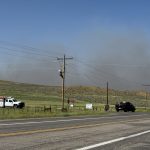County experts encourage clipping, bagging noxious weed seed heads now
Effective weed control requires countywide participation

Suzie Romig/Steamboat Pilot & Today
Routt County Noxious Weed Supervisor Tiffany Carlson this time of year is running and gunning, almost literally, trying to keep noxious weeds from going to seed.
Carlson is asking community members for assistance to help control the spread of damaging invasive weeds.
“We’re up against a tight window to complete effective management before noxious weeds reach seed set at the height of the field season,” Carlson said this week. “Managing weeds not only protects surrounding landscapes but also enhances property values and land usability. It’s truly in everyone’s best interest to take an active role in responsible weed management.”
Since weeds “do not observe property lines or jurisdictional boundaries,” Carlson said effective noxious weed control requires action and commitment countywide. She said timely identification and cooperative management are important so that early action can be taken to help significantly reduce future use of herbicides.
“Our goal is to safeguard ecosystems, soils, water, pollinators, native species and our region’s agricultural heritage,” Carlson said.
Colorado State University Extension Routt County Director Todd Hagenbuch also emphasized that noxious, invasive weeds can take over landscapes that should be home to native flora and fauna. Putting off dealing with or treating weeds only brings more extensive future problems, Hagenbuch said.
“Each year you wait, that just means a lot more work and damage for you in the future,” Hagenbuch said.
With stronger legal enforcement options that went into effect last year, the county is now cracking down on noncompliance of control of noxious weeds. Last year, the county issued 289 noxious weed notification letters and received a 53% response rate, Carlson said, and this year, another round of letters has gone out.

“Those who fail to respond or collaborate on a reasonable weed management plan may receive formal legal communication and could ultimately be referred to our attorney’s office,” Carlson explained. “Our office continues to pursue voluntary compliance, document cases, prioritize based on severity and prepare all necessary documentation for future legal steps.”
Carlson said the primary goal of the Routt County Weed Program is education and voluntary compliance, and the team hopes to avoid litigation whenever possible. This year’s county property tax notices included an insert explaining the new enforcement policy.
At work in early June spraying whitetop on the edge of a residential property within the county right of way, Carlson said whitetop noxious weeds remain a major focus and receives attention first from the county due to its early season emergence. Yet, several perennial species are rising in importance including Dalmatian toadflax, yellow toadflax, leafy spurge, Canada thistle and oxeye daisy.
“These typically require systemic herbicides as part of an integrated approach due to their extensive root systems,” Carlson said. “The earlier we identify and act on these, the more we can reduce long-term chemical use.”
Carlson said this week that dame’s rocket, oxeye daisy and hoary alyssum “are all concerning at the moment.” She said houndstongue in particular is thriving and in full bloom and entering seed set.
“To manage houndstongue effectively, we recommend clipping and bagging or burning flower seed heads and digging up the top 4 inches of the taproot,” Carlson said. “Leaves and stems can be left on the ground to decompose.”
The noxious weed supervisor advised people not to discard on the ground the small, round houndstongue seeds that often affix tightly to clothing and pets. All seed heads should be securely and carefully bagged and disposed of without dispersing.
Hagenbuch said Thursday that weeds such as curly dock, common mullein and musk and bull thistles are visible currently and are prolific seed producers but can be controlled by digging up those weeds and carefully bagging the seed heads. Residents, landowners and land managers can see photos in both early and late stages of noxious weed growth in the 2023 Routt County Weed Management Guide linked under the Resources section at Co.routt.co.us/216/Weed-Program.
The educators emphasize that weed management is everyone’s responsibility because even a small patch of weeds on private land can become a seed source and spread to agricultural or public lands. Seeds travel by many moving means include wind, water, birds, wildlife, car tires, shoes, bikes and pets.
The county weed experts advise use of an integrated weed management approach with consistent follow-through to control the invasive and damaging plants.
“While herbicides are often the most efficient and successful tool, we recognize that not everyone is willing to use them,” Carlson said. “For those opting out, other methods like timely mowing, pulling and root removal (depending on species) can still be effective but will require more time and resources over the long term.”

To reach Suzie Romig, call 970-871-4205 or email sromig@SteamboatPilot.com.

Support Local Journalism

Support Local Journalism
Readers around Steamboat and Routt County make the Steamboat Pilot & Today’s work possible. Your financial contribution supports our efforts to deliver quality, locally relevant journalism.
Now more than ever, your support is critical to help us keep our community informed about the evolving coronavirus pandemic and the impact it is having locally. Every contribution, however large or small, will make a difference.
Each donation will be used exclusively for the development and creation of increased news coverage.










